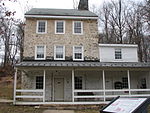Delaware–Maryland–Pennsylvania Tri-State Point
Borders of DelawareBorders of MarylandBorders of PennsylvaniaCultural boundariesHistoric Civil Engineering Landmarks ... and 1 more
Surveying of the United States

The Delaware–Maryland–Pennsylvania Tri-State Point is the meeting of the northwestern corner of Delaware, the northeastern corner of Maryland, and the southern edge of Pennsylvania. A wooden marker was placed in 1765, by Charles Mason and Jeremiah Dixon, and was replaced with a stone marker in 1849. A trail to the marker was made in 2014–2015.
Excerpt from the Wikipedia article Delaware–Maryland–Pennsylvania Tri-State Point (License: CC BY-SA 3.0, Authors, Images).Delaware–Maryland–Pennsylvania Tri-State Point
Tri-State Trail / Mason-Dixon Trail, London Britain Township
Geographical coordinates (GPS) Address Nearby Places Show on map
Geographical coordinates (GPS)
| Latitude | Longitude |
|---|---|
| N 39.722222222222 ° | E -75.788611111111 ° |
Address
Tri-State Marker
Tri-State Trail / Mason-Dixon Trail
19347 London Britain Township
Pennsylvania, United States
Open on Google Maps








